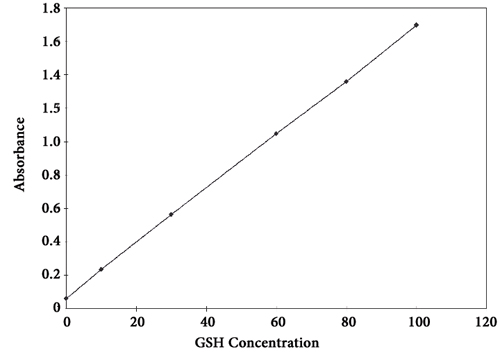Product Overview
Background
Glutathione (gamma-glutamylcysteinylglycine or GSH) is a naturally occurring tripeptide whose nucleophilic and reducing properties play a central role in metabolic pathways, as well as in the antioxidant system of most aerobic cells.1 GSH plays a critical role as a coenzyme with a variety of enzymes including, glutathione peroxidase, glutathione S-transferase, and thiol transferase. GSH also plays major roles in drug metabolism, calcium metabolism, the γ-glutamyl cycle, blood platelet, and membrane functions. In addition, GSH is crucial to a variety of life processes, including the detoxification of xenobiotics, maintenance of the -SH level of proteins, thiol-disulfide exchange, removal of hydroperoxides and free radicals, and amino acid transport across membranes. Physiological values of intracellular GSH generally range from 1 to 10 mM. Although many methods have been described for the assay of GSH, the reliable ones are labor intensive and not easy to use.2
Principle of the Assay
This method is based on a chemical reaction which proceeds in two steps. The first step leads to the formation of substitution products (thioethers) between a patented reagent, R1 (4-chloro-1-methyl-7-trifluromethyl-quinolinium methylsulfate), and all mercaptans (RSH) which are present in the sample.
The second step is a β-elimination reaction which takes place under alkaline conditions. This reaction is mediated by reagent R2 (30% NaOH) which specifically transforms the substitution product (thioether) obtained with GSH into a chromophoric thione which has a maximal absorbance wavelength at 400 nm. This method makes it possible to specifically assay glutathione with only one sampling and one colorimetric measurement. A modification of this method can be used to assay other mercaptans. This is based on the measurement of substitution products, thioethers, which absorb light at 356 nm in the absence of reagent R2. Because of its simplicity, this method is especially well adapted to the assay of glutathione in large series of biological samples. The main advantage of the method is the specificity for glutathione and it does not require an enzyme as a reagent.
Sample Standard Curve

References:
1. Dolphin, et al.,Glutathione: Chemical, Biochemical and Medical Aspects, Vols A & B, J. Wiley and Sons, 1989.
2. Anderson, et al., Glutathione: chemical, biochemical and medical aspects,Vol. A, J. Wiley and Sons, pp.339-365,1989.
